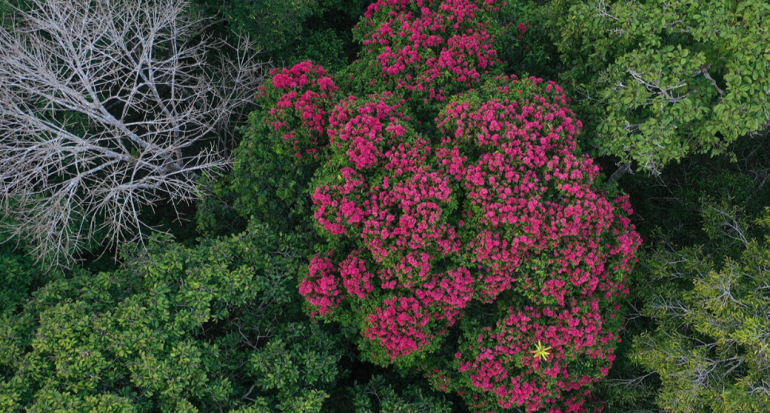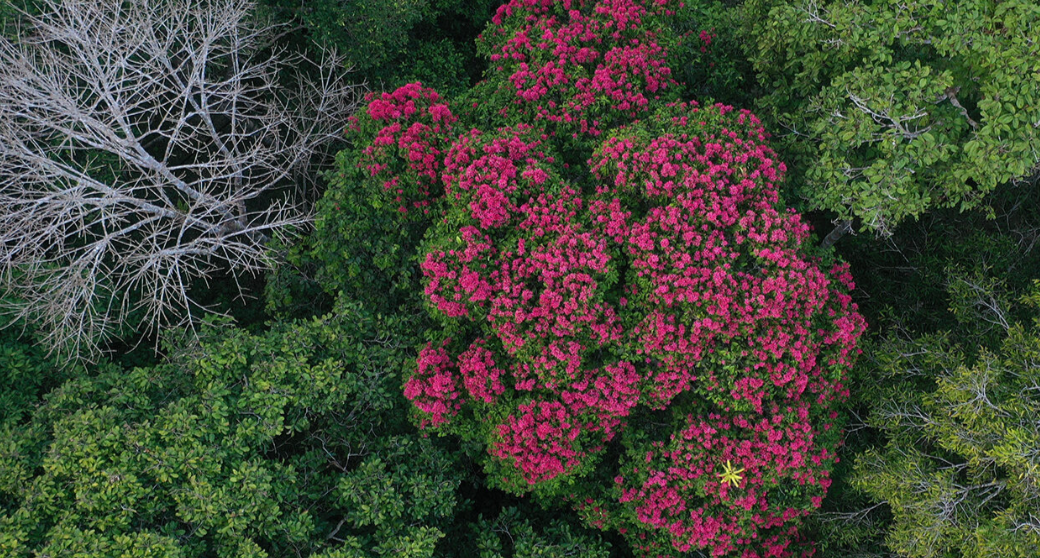
A flowering tree in the Amazon rainforest canopy. Photo credit: Rhett A. Butler
By Liz Kimbrough via Mongabay
A new study has for the first time identified the most common tree species in the tropical forests of Africa, the Amazon and Southeast Asia — and their similarities have surprised scientists.
“The [study] shows some uncanny similarities among the world’s great tropical rainforests,” said tropical ecologist Bill Laurance, a co-author of the study published in the journal Nature. “In terms of their tree communities, rainforests in the Amazon, Africa, and Southeast Asia are all dominated by a few surprisingly ‘common’ species. In each of these regions, about 2.2% of the tree species at any site account for fully half of all the trees there.”
Scientists at University College London (UCL) and 356 collaborating researchers analyzed more than 1 million trees across 1,568 locations. They found that despite the unique environmental conditions and histories of tropical forests on each continent, the patterns of tree diversity were strikingly similar. Just 2.2% of tree species accounted for 50% of all trees surveyed.
Using statistical techniques and resampling, the researchers compiled a list of the 1,119 most common tree species, the first time the prevalent trees have been identified.
 Location of the 1,568 plots, tropical forest regions, and tropical forest biome extent used in the study. Dots show the location of the plots analyzed, colored by continental region. Image courtesy of Cooper et al. (2024).
Location of the 1,568 plots, tropical forest regions, and tropical forest biome extent used in the study. Dots show the location of the plots analyzed, colored by continental region. Image courtesy of Cooper et al. (2024).
“We wanted to look at tropical forests in a new way. Focusing on a few hundred common tree species on each continent, rather than the many thousands of species that we know almost nothing about, can open new ways to understand these precious forests,” senior author Simon Lewis, a professor of global change science at UCL, said in a statement.
Africa’s forests are older and climatically different than the Amazon Rainforest or Southeast Asia’s fragmented island forests, yet all share core patterns of diversity. Despite unique origins and environments, the consistent proportion of common species points to possible universal mechanisms shaping tropical forests worldwide.
“Our findings have profound implications for understanding tropical forests,” said lead author Declan Cooper, a postdoctoral researcher at UCL. “If we focus on understanding the commonest tree species, we can probably predict how the whole forest will respond to today’s rapid environmental changes.”
More than 1,000 species comprise half of the estimated 800 billion tropical forest trees. The other half of the trees consist of 46,000 rare species, indicating a distribution of a few dominant species among many rare ones in tropical forests worldwide.
“Findings like this could also have important implications for forest conservation: it may be easier to predict how a few dozen common tree species will respond to future environmental threats, such as climate change or forest disruption, than will hundreds of rare species,” Laurance added.
However, this focus on the common species shouldn’t take away from the importance of the rare species, the authors note. The latter still play “indispensable roles” in the environment and should be protected, they add.
 Intact rainforest in Cuc Phuong in northern Vietnam. Image by Rhett A. Butler for Mongabay
Intact rainforest in Cuc Phuong in northern Vietnam. Image by Rhett A. Butler for Mongabay
This study was possible, Cooper said, due to the collection of tropical tree data by hundreds of pan-tropical and international researchers.
However, according to Jingjing Liang, a researcher in the Department of Forestry and Natural Resources at Purdue University, who wasn’t affiliated with the study, “the article underscores the surprising lack of knowledge surrounding even the most common tree species in tropical regions.”
Liang said the sampling density of trees is higher in developed countries than in developing ones, a discrepancy that “highlights a significant data gap that hampers our understanding of tropical forest ecosystems.”
Additionally, crucial forest data remain inaccessible and need to be shared, Liang said. “For example, the data associated with this article were redacted, withholding vital information like species identity… This presents a formidable barrier for scientists globally, particularly those from underrepresented backgrounds.”
“Addressing this issue requires a collaborative effort, recognizing a shared responsibility among forestry agencies at various government levels, scientists, indigenous communities, and biodiversity monitoring groups worldwide.”
To read the original article click here.
Citations:
Cooper, D. L., Lewis, S. L., Sullivan, M. J., Prado, P. I., ter Steege, H., Barbier, N., … Zent, S. (2024). Consistent patterns of common species across tropical tree communities. Nature, 625, 728-734. doi:10.1038/s41586-023-06820-z
Liang, J., & Gamarra, J. G. (2020). The importance of sharing global forest data in a world of crises. Scientific Data, 7(1). doi:10.1038/s41597-020-00766-x




 Location of the 1,568 plots, tropical forest regions, and tropical forest biome extent used in the study. Dots show the location of the plots analyzed, colored by continental region. Image courtesy of Cooper et al. (2024).
Location of the 1,568 plots, tropical forest regions, and tropical forest biome extent used in the study. Dots show the location of the plots analyzed, colored by continental region. Image courtesy of Cooper et al. (2024). Intact rainforest in Cuc Phuong in northern Vietnam. Image by Rhett A. Butler for Mongabay
Intact rainforest in Cuc Phuong in northern Vietnam. Image by Rhett A. Butler for Mongabay





